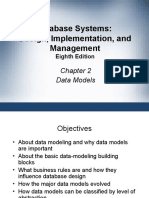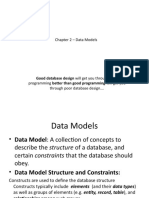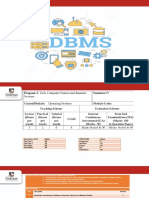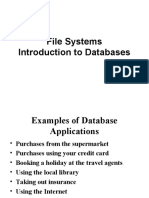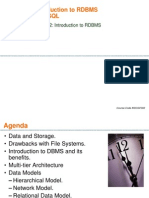Module 2 - Data Models
Uploaded by
dasalchinModule 2 - Data Models
Uploaded by
dasalchinDatabase Systems:
Design, Implementation, and
Management
Ninth Edition
Module 2
Data Models
Database Systems, 9th Edition 1
Objectives
In this chapter, you will learn:
• About data modeling and why data models are
important
• About the basic data-modeling building blocks
• What business rules are and how they influence
database design
• How the major data models evolved
• How data models can be classified by level of
abstraction
Database Systems, 9th Edition 2
Introduction
• Designers, programmers, and end users see
data in different ways
• Different views of same data lead to designs
that do not reflect organization’s operation
• Data modeling reduces complexities of
database design
• Various degrees of data abstraction help
reconcile varying views of same data
Database Systems, 9th Edition 3
Data Modeling and Data Models
• Data models
– Relatively simple representations of complex
real-world data structures
• Often graphical
• Model: an abstraction of a real-world object or
event
– Useful in understanding complexities of the
real-world environment
• Data modeling is iterative and progressive
Database Systems, 9th Edition 4
The Importance of Data Models
• Facilitate interaction among the designer, the
applications programmer, and the end user
• End users have different views and needs for
data
• Data model organizes data for various users
• Data model is an abstraction
– Cannot draw required data out of the data
model
Database Systems, 9th Edition 5
Data Model Basic Building Blocks
• Entity: anything about which data are to be
collected and stored
• Attribute: a characteristic of an entity
• Relationship: describes an association among
entities
– One-to-many (1:M) relationship
– Many-to-many (M:N or M:M) relationship
– One-to-one (1:1) relationship
• Constraint: a restriction placed on the data
Database Systems, 9th Edition 6
Business Rules
• Descriptions of policies, procedures, or principles
within a specific organization
– Apply to any organization that stores and uses data
to generate information
• Description of operations to create/enforce actions
within an organization’s environment
– Must be in writing and kept up to date
– Must be easy to understand and widely disseminated
• Describe characteristics of data as viewed by the
company
Database Systems, 9th Edition 7
Discovering Business Rules
• Sources of business rules:
– Company managers
– Policy makers
– Department managers
– Written documentation
• Procedures
• Standards
• Operations manuals
– Direct interviews with end users
Database Systems, 9th Edition 8
Discovering Business Rules (cont’d.)
• Standardize company’s view of data
• Communications tool between users and
designers
• Allow designer to understand the nature, role,
and scope of data
• Allow designer to understand business
processes
• Allow designer to develop appropriate
relationship participation rules and constraints
Database Systems, 9th Edition 9
Translating Business Rules into
Data Model Components
• Generally, nouns translate into entities
• Verbs translate into relationships among entities
• Relationships are bidirectional
• Two questions to identify the relationship type:
– How many instances of B are related to one
instance of A?
– How many instances of A are related to one
instance of B?
Database Systems, 9th Edition 10
Naming Conventions
• Naming occurs during translation of business
rules to data model components
• Names should make the object unique and
distinguishable from other objects
• Names should also be descriptive of objects in
the environment and be familiar to users
• Proper naming:
– Facilitates communication between parties
– Promotes self-documentation
Database Systems, 9th Edition 11
The Evolution of Data Models
Database Systems, 9th Edition 12
The Hierarchical Model
• The hierarchical model was developed in the
1960s to manage large amounts of data for
manufacturing projects
• Basic logical structure is represented by an
upside-down “tree”
• Hierarchical structure contains levels or segments
– Segment analogous to a record type
– Set of one-to-many relationships between
segments
Database Systems, 9th Edition 13
The Network Model
• The network model was created to represent
complex data relationships more effectively
than the hierarchical model
– Improves database performance
– Imposes a database standard
• Resembles hierarchical model
– However, record may have more than one
parent
Database Systems, 9th Edition 14
The Network Model (cont’d.)
• Collection of records in 1:M relationships
• Set composed of two record types:
– Owner
• Equivalent to the hierarchical model’s parent
– Member
• Equivalent to the hierarchical model’s child
Database Systems, 9th Edition 15
The Network Model (cont’d.)
• Concepts still used today:
– Schema
• Conceptual organization of entire database as
viewed by the database administrator
– Subschema
• Database portion “seen” by the application
programs
Database Systems, 9th Edition 16
The Network Model (cont’d.)
• Concepts still used today: (cont’d.)
– Data management language (DML)
• Defines the environment in which data can be
managed
– Data definition language (DDL)
• Enables the administrator to define the schema
components
Database Systems, 9th Edition 17
The Network Model (cont’d.)
• Disadvantages of the network model:
– Cumbersome
– Lack of ad hoc query capability placed burden
on programmers to generate code for reports
– Structural change in the database could
produce havoc in all application programs
Database Systems, 9th Edition 18
The Relational Model
• Developed by E.F. Codd (IBM) in 1970
• Table (relations)
– Matrix consisting of row/column intersections
– Each row in a relation is called a tuple
• Relational models were considered
impractical in 1970
• Model was conceptually simple at expense of
computer overhead
Database Systems, 9th Edition 19
The Relational Model (cont’d.)
• Relational data management system (RDBMS)
– Performs same functions provided by
hierarchical model
– Hides complexity from the user
• Relational diagram
– Representation of entities, attributes, and
relationships
• Relational table stores collection of related
entities
Database Systems, 9th Edition 20
Database Systems, 9th Edition 21
Database Systems, 9th Edition 22
The Relational Model (cont’d.)
• SQL-based relational database application
involves three parts:
– User interface
• Allows end user to interact with the data
– Set of tables stored in the database
• Each table is independent from another
• Rows in different tables are related based on
common values in common attributes
– SQL “engine”
• Executes all queries
Database Systems, 9th Edition 23
The Entity Relationship Model
• Widely accepted standard for data modeling
• Introduced by Chen in 1976
• Graphical representation of entities and their
relationships in a database structure
• Entity relationship diagram (ERD)
– Uses graphic representations to model
database components
– Entity is mapped to a relational table
Database Systems, 9th Edition 24
The Entity Relationship Model
(cont’d.)
• Entity instance (or occurrence) is row in table
• Entity set is collection of like entities
• Connectivity labels types of relationships
• Relationships are expressed using Chen
notation
– Relationships are represented by a diamond
– Relationship name is written inside the diamond
• Crow’s Foot notation used as design standard
in this book
Database Systems, 9th Edition 25
Database Systems, 9th Edition 26
The Object-Oriented (OO) Model
• Data and relationships are contained in a single
structure known as an object
• OODM (object-oriented data model) is the basis for
OODBMS
– Semantic data model
• An object:
– Contains operations
– Are self-contained: a basic building-block for
autonomous structures
– Is an abstraction of a real-world entity
Database Systems, 9th Edition 27
The Object-Oriented (OO) Model
(cont’d.)
• Attributes describe the properties of an object
• Objects that share similar characteristics are
grouped in classes
• Classes are organized in a class hierarchy
• Inheritance: object inherits methods and
attributes of parent class
• UML based on OO concepts that describe
diagrams and symbols
– Used to graphically model a system
Database Systems, 9th Edition 28
Database Systems, 9th Edition 29
Newer Data Models:
Object/Relational and XML
• Extended relational data model (ERDM)
– Semantic data model developed in response
to increasing complexity of applications
– Includes many of OO model’s best features
– Often described as an object/relational
database management system (O/RDBMS)
– Primarily geared to business applications
Database Systems, 9th Edition 30
Newer Data Models:
Object/Relational and XML (cont’d.)
• The Internet revolution created the potential
to exchange critical business information
• In this environment, Extensible Markup
Language (XML) emerged as the de facto
standard
• Current databases support XML
– XML: the standard protocol for data exchange
among systems and Internet services
Database Systems, 9th Edition 31
The Future of Data Models
• Hybrid DBMSs
– Retain advantages of relational model
– Provide object-oriented view of the underlying
data
• SQL data services
– Store data remotely without incurring expensive
hardware, software, and personnel costs
– Companies operate on a “pay-as-you-go” system
Database Systems, 9th Edition 32
Database Systems, 9th Edition 33
Data Models: A Summary
• Common characteristics:
– Conceptual simplicity with semantic
completeness
– Represent the real world as closely as possible
– Real-world transformations must comply with
consistency and integrity characteristics
• Each new data model capitalized on the
shortcomings of previous models
• Some models better suited for some tasks
Database Systems, 9th Edition 34
Database Systems, 9th Edition 35
Degrees of Data Abstraction
• Database designer starts with abstracted
view, then adds details
• ANSI Standards Planning and Requirements
Committee (SPARC)
– Defined a framework for data modeling based
on degrees of data abstraction (1970s):
• External
• Conceptual
• Internal
Database Systems, 9th Edition 36
The External Model
• End users’ view of the data environment
• ER diagrams represent external views
• External schema: specific representation of
an external view
– Entities
– Relationships
– Processes
– Constraints
Database Systems, 9th Edition 37
Database Systems, 9th Edition 38
The External Model (cont’d.)
• Easy to identify specific data required to
support each business unit’s operations
• Facilitates designer’s job by providing
feedback about the model’s adequacy
• Ensures security constraints in database
design
• Simplifies application program development
Database Systems, 9th Edition 39
Database Systems, 9th Edition 40
The Conceptual Model
• Represents global view of the entire database
• All external views integrated into single global
view: conceptual schema
• ER model most widely used
• ERD graphically represents the conceptual
schema
Database Systems, 9th Edition 41
Database Systems, 9th Edition 42
The Conceptual Model (cont’d.)
• Provides a relatively easily understood macro
level view of data environment
• Independent of both software and hardware
– Does not depend on the DBMS software used
to implement the model
– Does not depend on the hardware used in the
implementation of the model
– Changes in hardware or software do not affect
database design at the conceptual level
Database Systems, 9th Edition 43
The Internal Model
• Representation of the database as “seen” by the
DBMS
– Maps the conceptual model to the DBMS
• Internal schema depicts a specific representation
of an internal model
• Depends on specific database software
– Change in DBMS software requires internal model
be changed
• Logical independence: change internal model
without affecting conceptual model
Database Systems, 9th Edition 44
Database Systems, 9th Edition 45
The Physical Model
• Operates at lowest level of abstraction
– Describes the way data are saved on storage
media such as disks or tapes
• Requires the definition of physical storage
and data access methods
• Relational model aimed at logical level
– Does not require physical-level details
• Physical independence: changes in physical
model do not affect internal model
Database Systems, 9th Edition 46
Database Systems, 9th Edition 47
Summary
• A data model is an abstraction of a complex
real-world data environment
• Basic data modeling components:
– Entities
– Attributes
– Relationships
– Constraints
• Business rules identify and define basic
modeling components
Database Systems, 9th Edition 48
Summary (cont’d.)
• Hierarchical model
– Set of one-to-many (1:M) relationships between a
parent and its children segments
• Network data model
– Uses sets to represent 1:M relationships between
record types
• Relational model
– Current database implementation standard
– ER model is a tool for data modeling
• Complements relational model
Database Systems, 9th Edition 49
Summary (cont’d.)
• Object-oriented data model: object is basic
modeling structure
• Relational model adopted object-oriented
extensions: extended relational data model
(ERDM)
• OO data models depicted using UML
• Data-modeling requirements are a function of
different data views and abstraction levels
– Three abstraction levels: external, conceptual,
internal
Database Systems, 9th Edition 50
You might also like
- Database Systems: Design, Implementation, and Management: Data ModelsNo ratings yetDatabase Systems: Design, Implementation, and Management: Data Models50 pages
- Database Systems: Design, Implementation, and Management: Data ModelsNo ratings yetDatabase Systems: Design, Implementation, and Management: Data Models49 pages
- Chapter 2 - Data Models: Good Database Design Will Get You Through PoorNo ratings yetChapter 2 - Data Models: Good Database Design Will Get You Through Poor59 pages
- Data Models: Database Systems: Design, Implementation, and Management, Seventh Edition, Rob and CoronelNo ratings yetData Models: Database Systems: Design, Implementation, and Management, Seventh Edition, Rob and Coronel58 pages
- Chapter_2_Database_System_Concepts_and_Architecture_final_for_studentsNo ratings yetChapter_2_Database_System_Concepts_and_Architecture_final_for_students107 pages
- Lecture 1.2.1 - Data Models and Lecture 1.2.2 - Relational ModelNo ratings yetLecture 1.2.1 - Data Models and Lecture 1.2.2 - Relational Model24 pages
- Principles of Information: Systems, Tenth EditionNo ratings yetPrinciples of Information: Systems, Tenth Edition61 pages
- Database System Concepts and ArchitectureNo ratings yetDatabase System Concepts and Architecture44 pages
- EContent_11_2025_02_09_08_40_30_DBMS_UGCA1922_PPT2_DrAhmadpptx__2025_01_13_20_27_38No ratings yetEContent_11_2025_02_09_08_40_30_DBMS_UGCA1922_PPT2_DrAhmadpptx__2025_01_13_20_27_3828 pages
- Apex Institute of Technology: Department of Computer Science & EngineeringNo ratings yetApex Institute of Technology: Department of Computer Science & Engineering21 pages
- Prof. Ishani Saha Computer Department Mpstme (Nmims)No ratings yetProf. Ishani Saha Computer Department Mpstme (Nmims)38 pages
- Lecture 1.1 Overview of Databases and Lecture 1.2 DBMSNo ratings yetLecture 1.1 Overview of Databases and Lecture 1.2 DBMS21 pages
- Principles of Information Systems Eighth Edition: Organizing Data and InformationNo ratings yetPrinciples of Information Systems Eighth Edition: Organizing Data and Information60 pages
- Fundamentals of Information: Systems, Sixth EditionNo ratings yetFundamentals of Information: Systems, Sixth Edition56 pages
- All Basic Principles and Concept of DatabasesNo ratings yetAll Basic Principles and Concept of Databases83 pages
- Database Systems: Design, Implementation, and Management: Objectives100% (1)Database Systems: Design, Implementation, and Management: Objectives9 pages
- Fundamentals of Information Systems, Seventh Edition: Database Systems, Data Centers, and Business IntelligenceNo ratings yetFundamentals of Information Systems, Seventh Edition: Database Systems, Data Centers, and Business Intelligence63 pages
- Databases: System Concepts, Designs, Management, and ImplementationFrom EverandDatabases: System Concepts, Designs, Management, and ImplementationNo ratings yet
- Database Systems: Design, Implementation, and Management: Data ModelsDatabase Systems: Design, Implementation, and Management: Data Models
- Database Systems: Design, Implementation, and Management: Data ModelsDatabase Systems: Design, Implementation, and Management: Data Models
- Chapter 2 - Data Models: Good Database Design Will Get You Through PoorChapter 2 - Data Models: Good Database Design Will Get You Through Poor
- Data Models: Database Systems: Design, Implementation, and Management, Seventh Edition, Rob and CoronelData Models: Database Systems: Design, Implementation, and Management, Seventh Edition, Rob and Coronel
- Chapter_2_Database_System_Concepts_and_Architecture_final_for_studentsChapter_2_Database_System_Concepts_and_Architecture_final_for_students
- Lecture 1.2.1 - Data Models and Lecture 1.2.2 - Relational ModelLecture 1.2.1 - Data Models and Lecture 1.2.2 - Relational Model
- EContent_11_2025_02_09_08_40_30_DBMS_UGCA1922_PPT2_DrAhmadpptx__2025_01_13_20_27_38EContent_11_2025_02_09_08_40_30_DBMS_UGCA1922_PPT2_DrAhmadpptx__2025_01_13_20_27_38
- Apex Institute of Technology: Department of Computer Science & EngineeringApex Institute of Technology: Department of Computer Science & Engineering
- Prof. Ishani Saha Computer Department Mpstme (Nmims)Prof. Ishani Saha Computer Department Mpstme (Nmims)
- Lecture 1.1 Overview of Databases and Lecture 1.2 DBMSLecture 1.1 Overview of Databases and Lecture 1.2 DBMS
- Principles of Information Systems Eighth Edition: Organizing Data and InformationPrinciples of Information Systems Eighth Edition: Organizing Data and Information
- Fundamentals of Information: Systems, Sixth EditionFundamentals of Information: Systems, Sixth Edition
- Database Systems: Design, Implementation, and Management: ObjectivesDatabase Systems: Design, Implementation, and Management: Objectives
- Fundamentals of Information Systems, Seventh Edition: Database Systems, Data Centers, and Business IntelligenceFundamentals of Information Systems, Seventh Edition: Database Systems, Data Centers, and Business Intelligence
- Databases: System Concepts, Designs, Management, and ImplementationFrom EverandDatabases: System Concepts, Designs, Management, and Implementation
- DBMS MASTER: Become Pro in Database Management SystemFrom EverandDBMS MASTER: Become Pro in Database Management System

